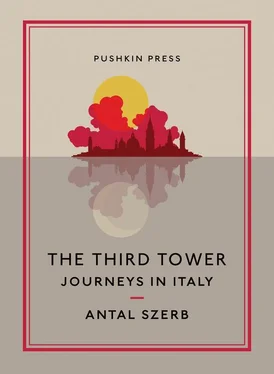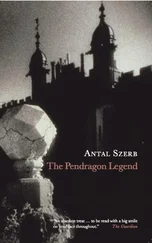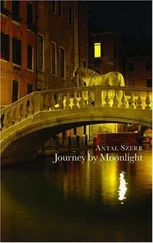On my first evening there I simply followed my nose and discovered a charming little trattoria , where they prepared a wonderful fritto misto for me, after which I drank a few glasses of a very agreeable Albano dolce. I always enjoy eating and drinking, but now that I am alone it is my chief pleasure and source of stimulation. This comes with solitude, it seems. I now understand the hearty appetite of Edvardas Turauskas, as well as his horror of loneliness.
Like him, I am eating and drinking a shocking amount. I want to savour every dish and every variety of beverage that Italy has to offer. My greatest regret is that in this heat I don’t always have much desire for wine. Sometimes in the evenings I set out to taste some really good local vintages and end up drinking orange juice. But I am not a real gourmet. I don’t have much feeling for the subtler nuances of Italian food and wine. It doesn’t matter to me how good they are, but how new to me, how unfamiliar. I am an incurable romantic.
I had finished the agreeable Albano dolce and was on my way back to the hotel when I had one of the most astonishing experiences of my entire trip. I was strolling contentedly along in the gloom when suddenly, as I entered one of the squares, a vision rose up before me — two enormous leaning towers, inclined at such an angle I thought I must be drunk. One soared up on my right, the other on the left, wobbling about in the silence and darkness and filling me with terror. They were Asinelli and Garisenda. They were as grotesquely fearsome and medieval in style as some of the poems of Milán Füst.
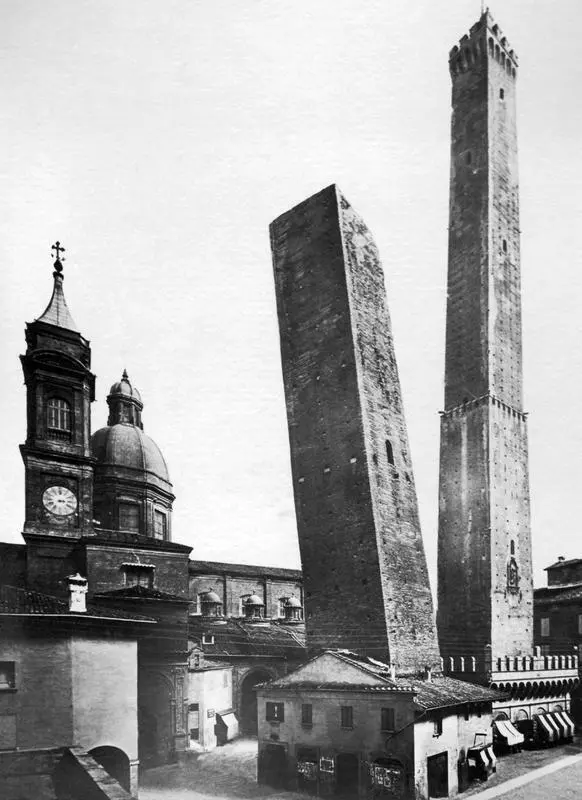
Later I learnt from Baedeker that these towers are the most famous landmark in Bologna. I am afraid even I should have known about them. I fear I am rather like the notorious American lady, Mrs Green, who tells us in the recently published account of her Italian travels that “the Tiber is a truly magnificent river, despite the fact that no one has ever heard of it”.
But to get back to the towers. Along with the serenity of Italy there is also a horrific side: the silent cypresses beside the cemeteries, the pitch-black alleyways, the rooftops bristling with battlements, the slanting towers. They correspond to something in the Italian soul. In his letters Shelley writes about the natives as if they were terrifying semi-savages, and to this day something of that lingers on in them. It is no accident that in their moments of grandeur they like to put on black shirts and go marauding, or march around in procession dressed up as bandits.
THE ACTUAL CITY is small and oppressive. The mayor leaves no stone unturned to ensure that the inhabitants are comfortable, and as a result the town is scattered with stone inscriptions advising you that, due to the narrowness of the street ahead, it is impossible to proceed, except by jumping from stone to stone, on one leg. The place feels abandoned, grim, deathlike. And no wonder. Ravenna has known three golden ages, the third ending in the eighth century AD, and it has decayed steadily ever since. No other city in Europe has been in a state of decay for so long. There is a particular reason for this: neither moral collapse nor politics, but geography. Ravenna was once a city on a lagoon, and before the rise of Venice it played the same role that its luckier rival did later, trading between the two shores of the Adriatic, and it was here, at nearby Classe, that the ancient naval harbour was built. But then the sea abandoned Ravenna. The lagoon dried up and filled with sand, and the city was left high and dry, like a stranded fish.
It continues to decay. The heat, the dust and the mosquitoes are made even more oppressive by the toxic fumes of a fertilizer factory, the presence of which can be felt in every part of the town. Whatever would the d’Estes and the Polentas have thought of this stench of industry?
But why do I always invoke these local petty tyrants, and why do they haunt my journey? Because one or two of them are of genuine interest, if not very much, and because they created buildings and a handful of imposing tombs to glorify their names beyond the grave. And because, every now and then — Cangrande in Verona and Guido Novello in Ravenna — they opened their houses to Dante.
Well, then: because they opened their houses to Dante, and because it was in this same abandoned Ravenna that Dante died and was buried, under the protection of Guido Novello. A gesture of which none of today’s petty tyrants would be capable.
So, this was the real goal of my travels, this run-down and evil-smelling town. It was one of the most passionate dreams of my youth to stand in person before the famous Byzantine mosaics, so faithfully preserved in the ancient basilica in Ravenna.
THE MOSAICS THEMSELVES — and this was the most surprising thing — did not disappoint. The moment I first caught sight of one I was seized by an intense perturbation. But perhaps that emotion really referred back to my youth, to a period from which all that remained was this urge to see Ravenna.
About these mosaics, the basilica itself and the fifteen-hundred-year-old burial sites, I have little to say that isn’t a commonplace of art history. The greatest surprise was simply that they are what they are. As art they were certainly no disappointment. What I had been told was all perfectly true: especially what I had always believed, that the Byzantine background in which the mosaics are placed is all of a uniform colour — a kind of gold, or a harrowing dark blue, or a wonderfully warm golden green. Below it is another field, bearing scenes of nature, hills and trees. But no one had mentioned how very different, how unexpectedly warm, is the interior of a basilica in which the windows are made of alabaster. The faces of the Emperor Justinian’s retinue are surprisingly modern, but that I already knew from reproductions.
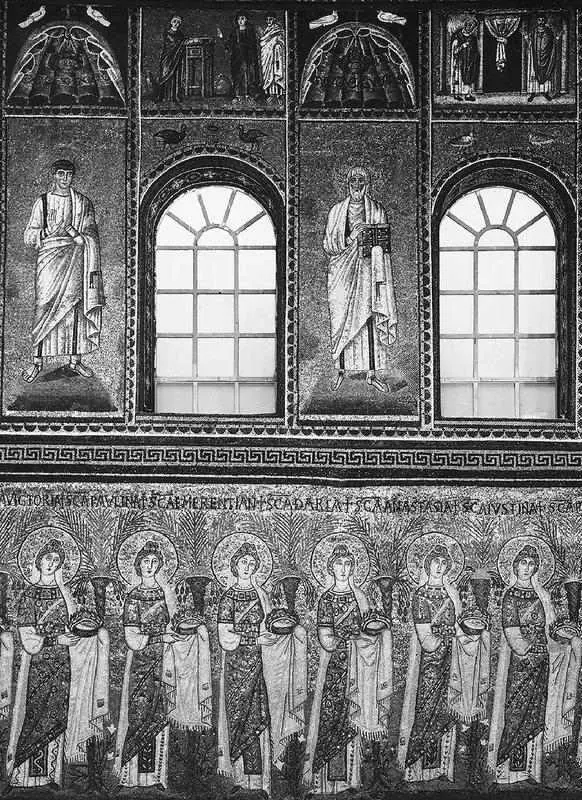
What moves one is the sheer antiquity. One begins to look on the Gothic intrusions and restorations with increasing resentment. How very parvenu, one thinks: mere thirteenth century! In these Byzantine images you find an almost baffling unity: on the one hand, a kind of urbane world-weariness, a courtly effeminacy in the gestures and faces; and on the other, a primitive innocence of technique. This two-sidedness is best seen in the heads of the columns in Sant’Apollinare Nuovo. Each has a double capital, an elaborately worked (and rather fine) Corinthian one, with a second immediately over it, the real one, that supports the arch above — a simple, unworked mass of stone, narrowing as it rises and covered in Byzantine religious symbols.
THE TOMB OF DIETRICH VON BERN
YOU PICK YOUR WAY across the railway tracks, registering the fumes of the fertilizer factory with redoubled strength, continue along a dusty main road for ten minutes, and there stands the tomb of Theodoric the Great. It is the strangest mausoleum I have yet seen in Italy. It is like nothing else: somehow not quite European. It is a message from the teeming, labyrinthine gloom of the first thousand years of Christianity, which Spengler describes as the “Arabian” or “Magical” period. The top consists of a formidable monolith. The interior is bare, with a huge porphyry bathtub in it — I have no idea why — and below it the grave. Here lies the ruler of the Ostrogoths. Here reposes the greatest dream of the Germanic peoples.
Читать дальше
